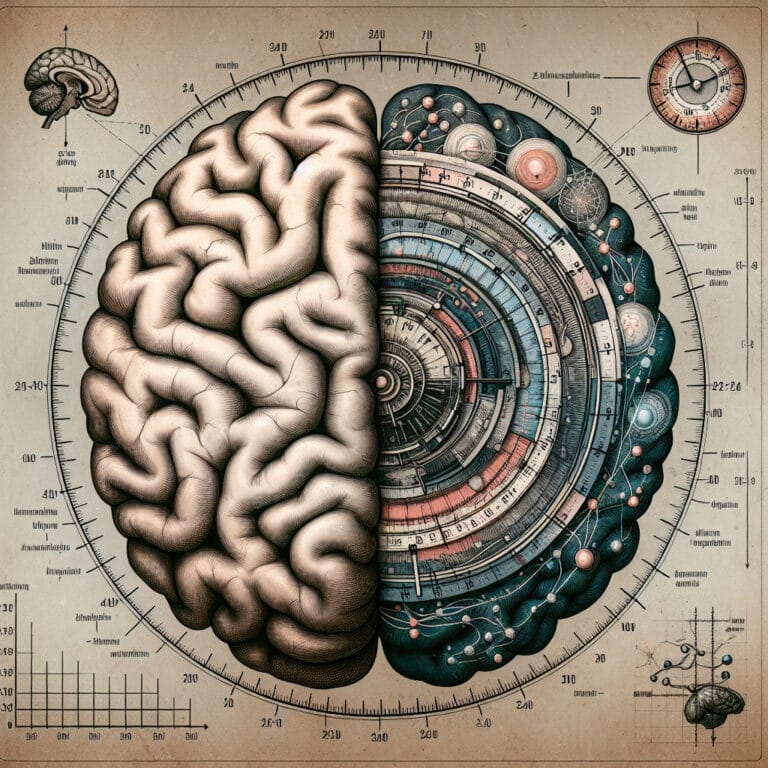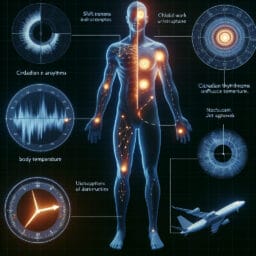
Understanding and Defining Circadian Rhythms: A Comprehensive Guide
Table of Contents
- Introduction
- Understanding Circadian Rhythms
- The Science behind Circadian Rhythms
- How to Maintain Healthy Circadian Rhythms
- Conclusion
- Frequently Asked Questions
Introduction
In the realm of biological rhythms, circadian rhythm stands out as an inherent and essential part of human life. Our bodies operate on a roughly 24-hour cycle that governs physiological processes, from fluctuating core body temperature to variations in alertness levels. This internal clock is controlled by the suprachiasmatic nucleus (SCN), often termed as the ‘master clock’, located within the brain’s hypothalamus. The SCN sends signals to regulate various bodily functions including sleep-wake cycles, aligning them with external stimuli such as light and darkness.
The importance of maintaining a healthy circadian rhythm cannot be overstated. Disruptions due to shift work or jet lag can lead to a range of health issues like sleep disorders or even disease control problems. When our daily schedule falls out of sync with our biological clocks, it results in what experts term ‘circadian misalignment’. Such misalignment may be seen in delayed sleep phase disorder where individuals find it hard to fall asleep at conventional times.
It’s worth noting that electronic devices emitting bright light can detrimentally affect circadian rhythms by tricking the pineal gland into suppressing melatonin production – crucial for initiating sleep. Thus, prioritizing good sleep hygiene practices like dimming lights during evening hours forms part of an effective strategy for maintaining robust circadian rhythms while mitigating risks associated with sleep deprivation or disruptions caused by traversing multiple time zones or abrupt shifts into daylight saving time.
Understanding Circadian Rhythms
Understanding the intricate workings of our biological clock presents an intriguing exploration into human physiology. The core of this system is the suprachiasmatic nucleus, often referred to as the master clock. This remarkable structure nestled within our brain’s hypothalamus acts as a maestro, adeptly orchestrating numerous physiological processes in harmony with a 24-hour cycle known as the circadian rhythm. One such process influenced by this internal clock is body temperature regulation, which fluctuates throughout the day reaching its peak in late afternoon and ebbing during sleep.
A host of external stimuli, including daylight hours and our daily schedule, also play pivotal roles in fine-tuning our circadian rhythms. For instance, bright light exposure from electronic devices before bedtime can adversely affect circadian rhythms by inhibiting melatonin production in the pineal gland. This hormone plays a critical role in regulating sleep-wake cycles and its suppression could delay your ability to fall asleep.
Our health is intricately entwined with these rhythms; disruptions caused by shift work or jet lag may lead to sleep disorders or exacerbate disease control issues due to circadian misalignment. Therefore, maintaining occupational safety involves not just managing physical hazards but also ensuring that work schedules align with natural sleep cycles where possible. Sleep hygiene practices such as establishing consistent sleep schedules and dimming lights during evening hours are vital components of a proactive strategy for bolstering healthy biological clocks while mitigating risks associated with sleep deprivation or traversing multiple time zones.
The Science behind Circadian Rhythms
In our quest to appreciate the workings of our circadian system, it’s intriguing to explore how light and darkness play a significant role in its regulation. It is indeed daylight that helps calibrate our internal clock, which is controlled by the suprachiasmatic nucleus – the master clock nested within the brain’s hypothalamus. This biological clock signals various bodily functions, including sleep-wake cycles, aligning them with external stimuli. As darkness falls, this prompts the pineal gland to produce melatonin, a hormone integral for instigating sleep. Conversely, bright light – particularly from electronic devices – can disrupt this process by tricking the body into thinking it’s still day time.
Now let’s delve deeper into what happens when these rhythms are disrupted due to shift work or jet lag – conditions that essentially force us out of sync with our natural sleep schedule and consequently lead to circadian misalignment. This is typically observed through symptoms like difficulty falling asleep or maintaining alertness during unsociable hours – both signs of potential sleep disorders.
Interestingly enough, genetic factors can also influence an individual’s sensitivity towards such disruptions in their circadian rhythm. Certain genetic mutations may render some more resilient against experience disruptions brought on by abrupt changes in time zones or adjustments due to daylight saving time while others may be more susceptible.
The importance here lies not just in understanding these dynamics but also implementing measures that support healthy habits around managing one’s biological clock effectively. When we prioritize good sleep hygiene practices such as maintaining consistent bedtimes and wake times across all days (including weekends), reducing exposure to bright light in evening hours and ensuring quality rest each night, we set ourselves up for better overall health and wellbeing while mitigating risks associated with chronic diseases often linked with prolonged sleep deprivation.
| Aspect | Description |
|---|---|
| Role of Light and Darkness | Daylight helps calibrate our internal clock. As darkness falls, the pineal gland produces melatonin, which instigates sleep. Conversely, bright light can disrupt this process. |
| Disruption of Circadian Rhythms | Conditions such as shift work or jet lag can lead to circadian misalignment. Symptoms include difficulty falling asleep or maintaining alertness during unsociable hours. |
| Genetic Factors | Genetic factors can influence an individual’s sensitivity towards disruptions in their circadian rhythm. Certain genetic mutations may render some more resilient against disruptions while others may be more susceptible. |
| Importance of Healthy Habits | Implementing measures that support healthy habits around managing one’s biological clock effectively is crucial. These include maintaining consistent bedtimes and wake times, reducing exposure to bright light in evening hours, and ensuring quality rest each night. |
How to Maintain Healthy Circadian Rhythms
The synchronization of your circadian clock with your daily schedule is an essential ingredient for achieving optimal health. Akin to a maestro conducting an orchestra, the suprachiasmatic nucleus – your ‘master clock’ nestled in the hypothalamus, conducts various bodily functions including sleep-wake cycles and body temperature regulation. This internal clock sends signals in tune with a 24-hour cycle, aligning these processes seamlessly with external stimuli such as light and darkness.
When this rhythm faces disruptions from shift work or crossing multiple time zones due to travel (aka jet lag), it can lead to what’s known as circadian misalignment. The consequences? Sleep disorders, difficulty falling asleep, and even disease control issues may arise due to this mismatch between our biological clocks and the societal imposed timing.
What if you could harness the power of routine to keep your circadian system humming harmoniously? Regularity in sleep schedules proves invaluable here – making it a point to adhere consistently not only lends stability but also aids in averting delayed sleep phase disorder where one finds it challenging to fall asleep at conventional times.
Natural light is another key player; exposing yourself during daylight hours helps calibrate your internal clock, while being cautious about exposure to bright light from electronic devices close to bedtime can prevent suppression of melatonin – critical for initiating sleep.
Don’t underestimate diet and exercise either! Healthy eating habits synced with your body’s natural rhythms promote digestive health whereas regular physical activity can reinforce consistency, cueing up physiological events like core body temperature fluctuation perfectly aligned with your internal master clock.
Remember, cultivating these habits forms part of occupational safety too; they help maintain alertness levels reducing risks associated with prolonged sleep deprivation while fostering better overall wellbeing. Watch those rhythms dance in harmony!
Conclusion
Our biological clock, also known as the circadian system, is a vital cog in the mechanism of our body’s daily functioning. It ensures that our sleep-wake cycles, core body temperature regulation and many other physiologic processes align with external stimuli such as daylight hours and darkness. This internal master clock, controlled by the suprachiasmatic nucleus in our brain’s hypothalamus, sends signals to various bodily functions in sync with a 24-hour cycle – the circadian rhythm. Factors like shift work or crossing multiple time zones can disrupt this rhythm leading to circadian misalignment which manifests as sleep disorders or difficulty falling asleep. However, maintaining regular sleep schedules and exposure to natural light during daytime can help calibrate your internal clock while reducing bright light exposure from electronic devices close to bedtime can prevent melatonin suppression – crucial for initiating sleep. Healthy eating habits and regular physical activity further reinforce these rhythms contributing not just to individual health but also occupational safety.


